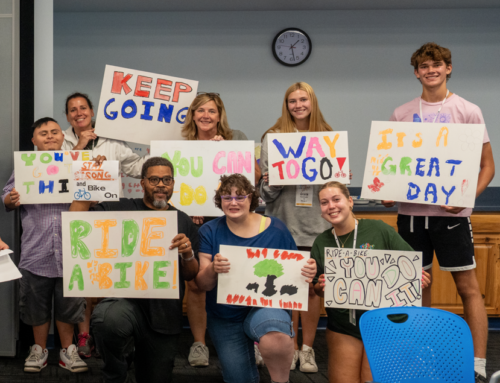More info: What is the ADA? | ADA FAQs
On July 26, 30 years ago, President George H.W. Bush famously declared “let the shameful wall of exclusion finally come tumbling down” at a ceremony before signing the Americans With Disabilities Act. The wheelchair ramps, IDD protections and mostly-unrestricted access to jobs that many of our clients benefit from today became law in 1990, minutes after that emphatic speech closer.
The country’s leaders united to make the ADA possible. A law whose time was long-overdue, the ADA passed congress, 377-28, and the senate, 91-6. The President would later give credit to “Democrats and Republicans in the Congress without whose support this never would have happened. Some of them didn’t agree with me on anything else except the ADA.
“The bottom line was, I felt that a lot of people with disabilities could be wonderfully productive citizens if some of the laws were changed. It was an easy call for me.”
Looking back 30 years later, our nation’s bipartisan leaders on Capitol Hill and the White House’s notion proved correct. The ADA has literally opened countless doors across America by making facilities more accessible to the physically disabled. The ADA has figuratively opened doors across America by providing access to the intellectually disabled. ADEC’s clients benefit every day from the ADA. This is something to celebrate.
Lawmakers and the President together pictured the possibilities of things Americans with disabilities could do and acted to make them happen. The bill’s author, long-time Iowa senator Tom Harkin, said proudly of the ADA’s passage “congress opens the doors to all Americans with disabilities — today we say no to ignorance, no to fear, no to prejudice.”
“I supported the ADA because I think it was the fair and right thing to do,” President Bush said. “I think there are a lot of people who if given access to the workplace, for example, can achieve things. But if they are denied that, they won’t have a shot at the American dream. It seemed to me that legislation was needed that provided as much fairness, as much access as possible.”
Clearly the 30th anniversary of Americans with Disabilities Act is something for ADEC to celebrate. ADEC lost its largest annual fundraiser in May when Ride-A-Bike had to be cancelled due to the novel coronavirus and needed a replacement. The challenge was presented to donor developer Troy Smith and it’s time to share his idea of fusing the two.
“The ADA is something that provides the source of the possibilities we at ADEC celebrate,” Smith said. “Our mission statement is that we’re providing informed choice and possibility. When you look at how do we accomplish that, it’s because of legislation like the ADA. It’s something we already celebrate but this year especially, the 30th anniversary, is a very significant milestone.
“We look at all of these ADEC programs which wouldn’t be possible without the ADA. When we talk about picturing possibilities here at ADEC, we remember the ADA but we also remember the community that helps make those programs possible because it is the community that funds several of our important programs and not Medicaid as many may think. It’s only the support from the community that allow us to offer additional options for programs like guardianship, family services, our skills and training center or transportation.
“So, Picture Possibilities serves multiple purposes. ADEC is all about community and our intention is that the individuals we serve always have access to the community and the community has access to them. Years ago, at institutions, it was all about keeping people behind closed doors. Now, we want to open those doors wide. Our events, like Ride-A-Bike, brings everyone together. With COVID-19, we can’t do that. But, our virtual fundraiser allows people to see each other doing similar activities so we can all feel like we’re together.”
Smith went to work shortly after the cancellation of Ride-A-Bike trying to figure out how to create a comparable fundraiser that brings people together in a fun setting without actually bringing them together. Once the lightbulb turned on, Smith fervently cobbled together a plan for “Celebrate the Possibilities.” After it gained the blessing of ADEC President and CEO Donna Belusar it went through a series of alterations from full-community outreach staff brainstorming sessions.
What emerged is Picture Possibilities. ADEC staff and clients immediately showed an eagerness to participate and the hope is for a similar feeling from our community that we missed on May 16 when we couldn’t hold Ride-A-Bike as planned.
“Picture Possibilities was inspired by the question of how can we do something virtual but together,” Smith said. “We get to see each other’s faces. We get to do similar activities. Our four different challenges are all inspired by things we do at ADEC. The active challenge – the individuals we serve love to play Wii or dance together or ride a bike. The art challenge – our Art by ADEC program is a wonderful opportunity to see how amazing and talented the individuals we serve are. It’s an opportunity for them to show the world what they’re passionate about, what ADEC is passionate about and invite the world to be a part of it.”
Thirty years ago, July 26, President Bush invited the world to watch a signing ceremony on the south lawn of the White House to celebrate something organizations like ADEC and the self-advocates we serve had been passionate about – equal rights.
“And now I sign legislation which takes a sledgehammer to another wall – one which has for too many generations separated Americans with disabilities from the freedom they could glimpse but not grasp,” President Bush said that sunny summer day.
In 1990, congress, the senate and the President collectively pictured the possibilities of those living with disabilities and encouraged them. In 2020, ADEC is picturing the possibilities of the pictures you could take and videos you could make to help support our clients.










